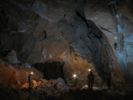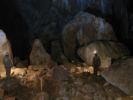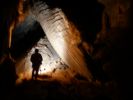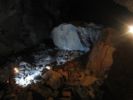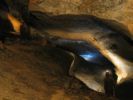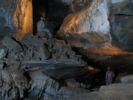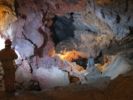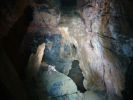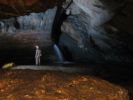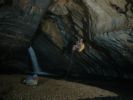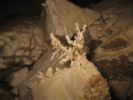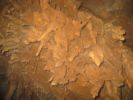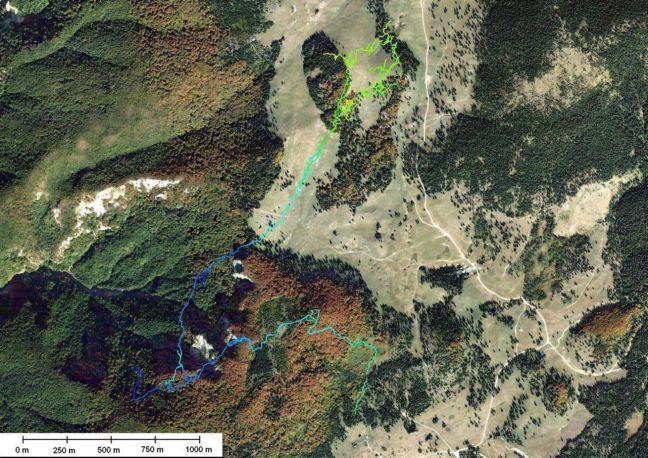 |
|||||

|
| ||||
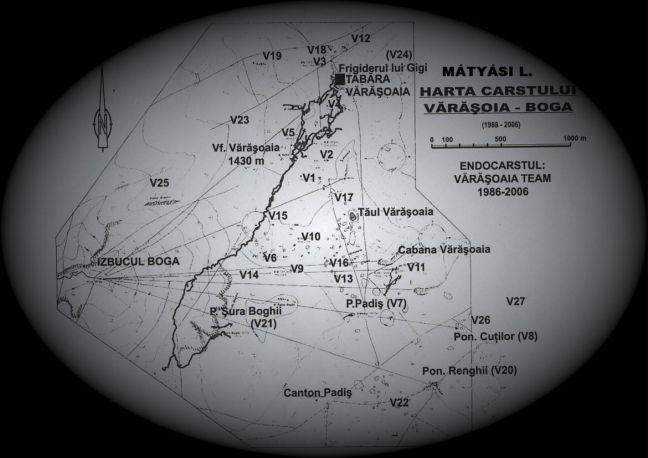
 The Vărăşoaia closed depression is located in central-North part of the Bihor Mountains, in the northern extremity of the Padiş-Cetăţile Ponorului closed catchment basin, at an elevation of 1150 - 1250 m. From morphological point of view it consist of the capture depressions of Vărăşoaia-North and Vărăşoaia-South, from the primary trail of the Padiş paleo-valley. The depression formed along the tectonic contact between the Permian-Werferian (a.k.a. Scythian Stage) quartz arenites (sandstone) - located in the eastern corner (represented in relief by the Mount Măgura Vânătă) - and the Anisian-Ladinian limestones and dolomites in the western corner, as a result of subterrainification of the streams originating from the western slopes of Mount Măgura Vânătă and disappear through the sinkholes at the contact points with the karstifiable rocks. The sinkholes of the region, located between 1150 - 1250 m elevation are situated in a shape of a fan in relation to the system resurgence called "Izbucul Boga" (669.6 m elevation), situated at an aerial distance of about 2 - 2.5 km from the aforementioned sinkholes.
The relevant karstic system is represented by the V5 pothole, the deepest cavern in Romania (-653 m elevation difference), its entrance can be fount at 1366.9 m absolute elevation, with a potential elevation difference to the resurgence, Izbucul Boga, being 697.3 m.
The research dedicated to this system commenced right after the system's hydro-karstic proving after stream tracings carried out by Iancu Orăşeanu in the year of 1985. The intensive search and reconnaissance of the area started in 1986 by the deceased Paul Matos, whose activities lead to the discovery of seven new caverns, including V5.
V5 pot is located on the east slope of Mount Vărăşoaia, on the watershed between the closed depressions Vărăşoaia-South and Vărăşoaia-North, at an elevation 1366.9 m and it was discovered in the year of 1986. Repeated rock excavations coordinated by the "Z" Caving Club resulted in reaching the depth of -273 m in the year of 1992, -643 in 2004 and -653 m in 2005. The extension of this cave system is over 19 km, and contains the second largest chamber in Romania, 1.2 million m3, called "Sala Paul Matos", thus named as a remembrance of the initiator of the karst explorations in the area of Vărăşoaia - Boga.
The Vărăşoaia closed depression is located in central-North part of the Bihor Mountains, in the northern extremity of the Padiş-Cetăţile Ponorului closed catchment basin, at an elevation of 1150 - 1250 m. From morphological point of view it consist of the capture depressions of Vărăşoaia-North and Vărăşoaia-South, from the primary trail of the Padiş paleo-valley. The depression formed along the tectonic contact between the Permian-Werferian (a.k.a. Scythian Stage) quartz arenites (sandstone) - located in the eastern corner (represented in relief by the Mount Măgura Vânătă) - and the Anisian-Ladinian limestones and dolomites in the western corner, as a result of subterrainification of the streams originating from the western slopes of Mount Măgura Vânătă and disappear through the sinkholes at the contact points with the karstifiable rocks. The sinkholes of the region, located between 1150 - 1250 m elevation are situated in a shape of a fan in relation to the system resurgence called "Izbucul Boga" (669.6 m elevation), situated at an aerial distance of about 2 - 2.5 km from the aforementioned sinkholes.
The relevant karstic system is represented by the V5 pothole, the deepest cavern in Romania (-653 m elevation difference), its entrance can be fount at 1366.9 m absolute elevation, with a potential elevation difference to the resurgence, Izbucul Boga, being 697.3 m.
The research dedicated to this system commenced right after the system's hydro-karstic proving after stream tracings carried out by Iancu Orăşeanu in the year of 1985. The intensive search and reconnaissance of the area started in 1986 by the deceased Paul Matos, whose activities lead to the discovery of seven new caverns, including V5.
V5 pot is located on the east slope of Mount Vărăşoaia, on the watershed between the closed depressions Vărăşoaia-South and Vărăşoaia-North, at an elevation 1366.9 m and it was discovered in the year of 1986. Repeated rock excavations coordinated by the "Z" Caving Club resulted in reaching the depth of -273 m in the year of 1992, -643 in 2004 and -653 m in 2005. The extension of this cave system is over 19 km, and contains the second largest chamber in Romania, 1.2 million m3, called "Sala Paul Matos", thus named as a remembrance of the initiator of the karst explorations in the area of Vărăşoaia - Boga.
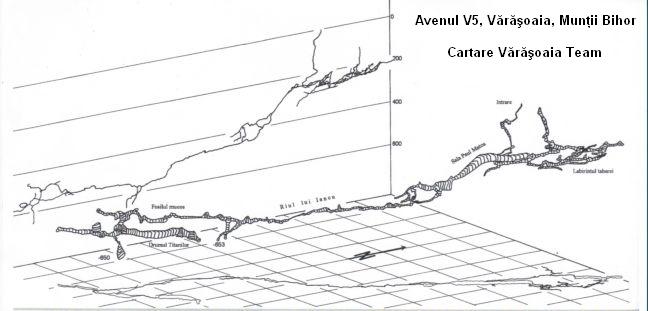
The network of underground passages projected on satellite image containing the Vărăşoaia Depression, the Padiş Plateau and the Boga Resurgence. Exploration History

The V5 Pot was discovered in August 1986 by P. Damm and M. Damm, when the entrance was opened up and after an other digging-session performed at -5 m a severe squeeze was reached at -13 m. In September 1987 P. Damm ("Z"), K. Moréh, Gy. Keserü ("Ursus Spelaeus" Tg. Mureş) pass through this obstacle by rock excavation reaching -31 m. During the period of July 1988 - January 1989 P. Matos, R. Pop, C. Constantin, G. Radics, D. Ciocan, C. Pop, M. Botez şi G. Popa ("Speotelex" Cluj, "Emilian Cristea" Alba Iulia, Alpin Grup Timişoara) force through two squeezes, the last one of these requiring in excess of 40 hours of work before it could be passed. These efforts led to the discovery of "Complexul Sălilor Mari" (=The Complex of the Large Halls), "Galeria Meandrului" (=The Gallery of the Meander) and "Reţeaua Paralelă" (=The Parallel Network).
In August 1988 the first surveying of the cavern was performed by Cs. Csák and Erzsébet Orbán ("Czárán Gyula" Tinca) reaching 300 m lenght and -104 m elevation difference. In July 1989 P. Damm, Z. Kiss, R. Pop, I. Szlány, G. Popa ("Z" Oradea, "Speotelex" Cluj, Alpin Grup Timişoara) create the topographic survey of the entire cave known at the time.
Simultaneously start the rock excavations at the end of the Hall of Aragonites (-77 m), an endeavour in which several clubs take part ("Speotelex", "Emilian Cristea", "Z" and "Labirint" Bucureşti), succeeding to overcome this last obstacle, too, in the year of 1991. In the explorations that followed, coordinated by J. Zih ("Z") and R. Pop ("Speotelex"), and much hampered by the highly difficult journey through the cave, participated: O. Pop, G. Frăţilă ("Politehnica" Cluj), P. Damm, Sz. Szűcs, C. Pop, Magda Bartos ("Z"), Katalin Perényi (MAFC Budapest), D. Ciocan, M. Banc, L. Forda ("Emilian Cristea") and I. Chiseliţă (CSER Cluj). Following some rock excavations and forcing a passage opened to penetration limit at the depth of -126 m advancement was possible to an impenetrable sump located at a depth of -273 m.
Nearly 10 years followed during which V5 Pot was completely forgotten, only a couple of fanatics still trying to force some suspected leads. During one of these trips around -200 a suspended meander was discovered at about 10 m height. After this about 10 rock excavation events followed utilizing "modern" technology of rock displacement. Finally, with the occasion of a "Vărăşoaia Summer Camp" in 2004 the 50 m squeeze was passed through getting to a shaft that descends into an enormous space. The hall was named "Paul Matos" in memoriam of the explorers' colleague who deceased in 1989. The dimensions are indeed mind-blowing: 410 m length, 50-70 m width, 30-50 m height, having a volume of more than 1 million cu. m.
The discovery of 2004 represented a new era in the history of the cave. From than on there were yearly speleo-camps organized, called "Tabăra Vărăşoaia", the number of participants increasing every year. The explorations continued downstream from the Paul Matos Hall. At the end of the quite steep hall, which at the base of it has a chaotic agglomeration of enormous boulders many of them larger than a house, at the depth of -335 m a large shaft opens up. The drop is broken up into several steps, descending more than 100 m in elevation, leading into a canyon-like passage with a massive underground river passing through it (named Iancu's River). The morphology of this river is extremely varied, from a canyon type passage of 30 m height, through laminars developed along the face of layers, to the zone of cyclopean troubled collapses called "Negrul Nesfârşit"(=The Endless Black). The depth reached at the end of the year 2004 was -643 m, and in 2005 was -653 m.
With the occasion of the August 2007 camp the entrance in a work site was forced, which is located in the close proximity of the camp, called "Frigiderul lui Gigi" (=Gigi's Fridge), thus discovering a decent size underground cavity. In 2008 the link with V5 was made. The exploration of the pothole is in full swing by the Vărăşoaia Team members, discovering hundreds of meters of new passages during each caving trip.
|
|||||

|
|||||

